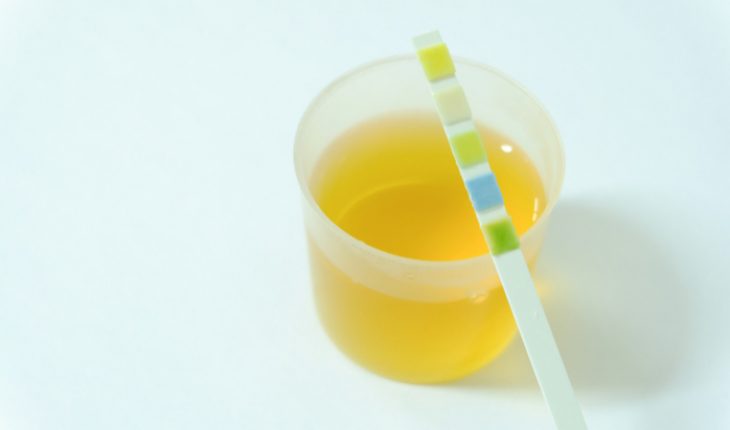Cystitis is an inflammation of the bladder and is a common type of urinary tract infection. Others UTIs include acute pyelonephritis, which affects the kidneys and can lead to loin pain and high fever, and urethritis, which is inflammation of the tube that carries urine from the bladder outside the body.
‘Cystitis, which is caused by microbes such as bacteria invading the bladder wall, doesn’t always cause symptoms but common signs you have the infection include a burning sensation when passing water, a strong persistent urge to urinate and passing frequent, small amounts of urine,’ says Mr Con Kelleher, a obstetrician and gynaecologist based at Guy’s and St Thomas’ NHS Foundation Trust. Blood in the urine, which can make it look pink and cloudy, is a more serious sign of cystitis but can also indicate other problems such as bladder cancer.
Blood in the urine, which can make it look pink and cloudy, is a more serious sign of cystitis but can also indicate other problems such as bladder cancer.
Cystitis, which is not normally serious but can lead to complications if left untreated, affects over 90 per cent of women at some point in their lives and is far more common among women than men. ‘This is because the anus is closer to the urethra in women and the urethra is much shorter,’ explains Mr Kelleher. ‘This means it is more likely that bacteria will invade the tract that carries urine from the kidneys to the bladder and down the urethra.’
Women during and after the menopause are twice as likely as younger women to develop cystitis. ‘As oestrogen levels fall, the lining of the urethra can shrink and become thinner. The balance of bacteria within the vagina also changes, which may allow potentially harmful bacteria to proliferate,’ explain Mr Kelleher.
Tests for cystitis usually look for bacteria, but around 400,000 people in the UK (90 per cent of them are women who tend to be aged between 30 and 45) suffer from a type of cystitis that isn’t caused by infection at all. Vik Khullar, a consultant urogynaecologist at Imperial College London explains that this can be due to tightening and tension in the pelvic floor due to conditions such as endometriosis or hysterectomy. Instead of frequent doses of antibiotics, these patients often need muscle relaxing drugs as well as physiotherapy to relax the pelvic floor, he says. Misdiagnosis happens frequently. ‘Pelvic floor dysfunction is hard to detect and patients come to me having been told there is nothing that can be done and it is all in their mind,’ says Mr Khullar.
Men who have an inflamed and infected prostate gland (prostatitis) can also find that they suffer from more frequent bladder infections too because bacteria can multiply more easily.
Other conditions that increase the risk of developing UTIs are diabetes, which make urine more sugary and therefore create a good environment for bacteria to multiply as well as bladder stones which make it difficult to empty the bladder fully. Pregnant women are also more at risk of developing a bladder infection as the baby may be pressing on the bladder as it grows in the womb.
Sex is a common trigger for cystitis, as this helps bacteria to gain access to the woman’s urethra. ‘Pressure and friction and multiple sex encounters over a short space of time can raise the risk,’ says Emma Soos, a registered nurse with a special interest in urology and director of the Women’s Health Clinic, which has six private health centres across England
‘UTIs can be very painful and should not be ignored since they can lead to more serious complications such as kidney infection as the bacteria travel from the bladder up the ureters,’ says Emma Soos.
The usual way to diagnosis cystitis is to perform a urine dipstick test to see if there is bacteria, blood or pus in urine which can be done by a GP. A doctor or nurse who is a specialist in urology may also perform a procedure called a cystoscopy when a thin tube with a light and camera attached is inserted via the urethra into the bladder to look for signs of inflammation and infection. You will usually be referred to hospital for this as an outpatient. ‘This is usually only done if a patient has repeated infections and we can’t work out why,’ says Emma Soos. Scans including X-ray or ultrasound are only used if other causes of bladder inflammation are suspected, such as a tumour. ‘You don’t need to get burning or pain to have cystitis, but if it is difficult to wee, get checked out,’ says Emma Soos.
What to do about it
If you have mild cystitis, symptoms may ease if you drink plenty of water to help flush harmful bacteria through the bladder and ureters. Although many people believe that cranberry juice or extract can help fight bladder infections, recent research by the Yale School of Medicine found no evidence that the fruit, taken as capsules, made any difference to the presence of bacteria in urine – a tell-tale sign of urinary tract infections.
But antibiotic treatment is mainstay for the treatment of cystitis. Trimethoprim (Monotrim) is commonly used because it is well tolerated and works in 80 per cent of infections. In the other 20 per cent the bacteria are resistant to the first-line drugs,’ says Mr Mike Bowen, a consultant gynaecologist based in Oxford and London. According to NICE guidelines, adults with UTIs which are not responding to treatment hould have a urine culture to identify the bacteria that are causing the problem so that they can be targeted with specific antibiotics which they are sensitive to.
However, according to the Cystitis and Overactive Bladder Foundation, thousands of women are not being given the correct antibiotics in high enough doses to cure their condition – they say that dip stick tests, which are strips that change colour when dipped into in infected urine, are unreliable and can miss up to 50 per cent of infections, so women are sent home without proper treatment. Professor Malone Lee, based at University College Hospital is now championing a return to an older microscope method which looks for live bacteria in a fresh urine sample done immediately. He also advocates, for some patients, high-dose long-term treatment with highly targeted antibiotics, although he accepts that this is less than ideal with the growing problem of antibiotic resistance, ‘but we shouldn’t let this be used as an excuse to deny treatment to patients who need them .’ NICE guidelines recommend a 3-5 day course of antibiotics for uncomplicated UTIs and 5-10 days when there is a more complicated problem and the patient has other underlying health issues. He recommends a very targeted antibiotic (specific for each patient) combined with an antiseptic medication Hiprex which stops the growth of bacteria in the urine.
- Biden Declines Second Term: Health Concerns - 23rd July 2024
- New catheter coating stops bacteria cells from swarming - 10th June 2024
- AI-designed catheters could dramatically reduce urinary tract infections - 10th June 2024







